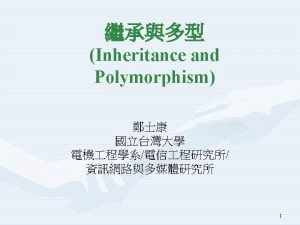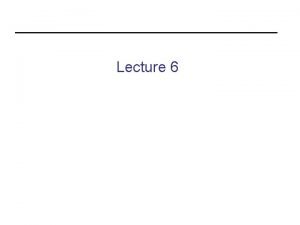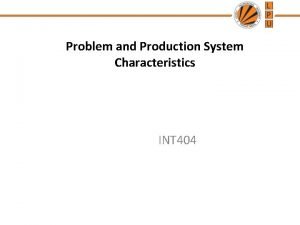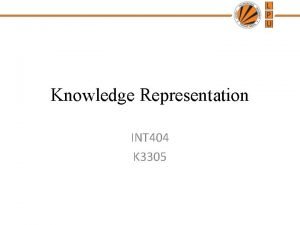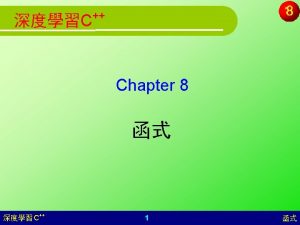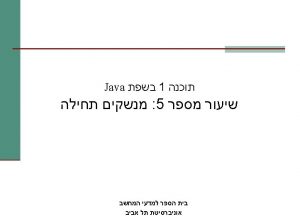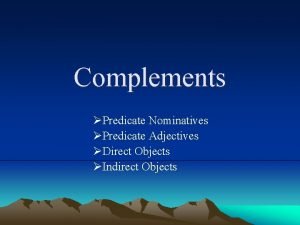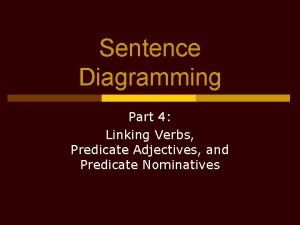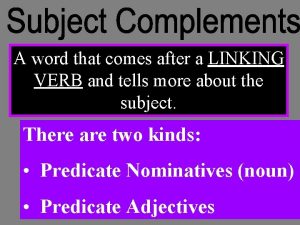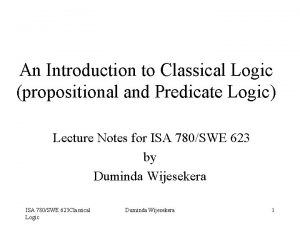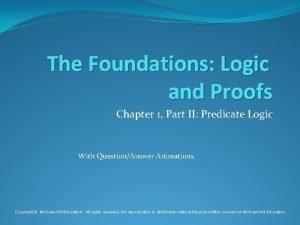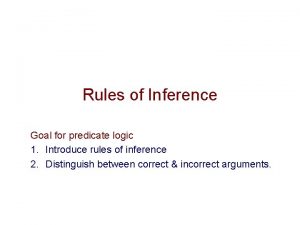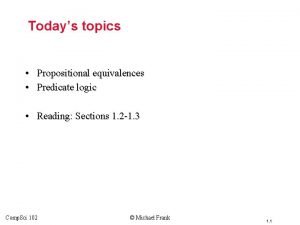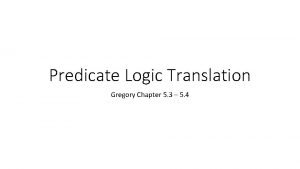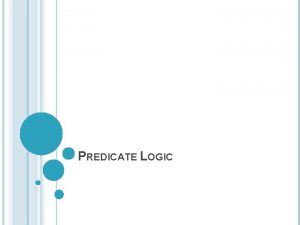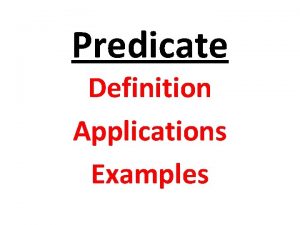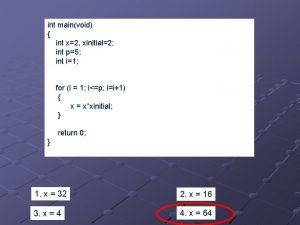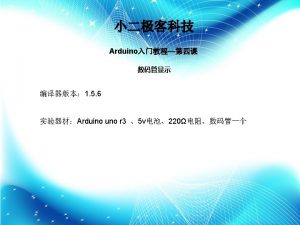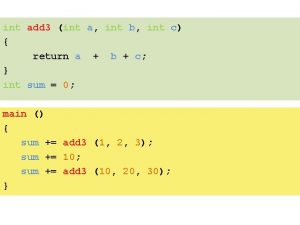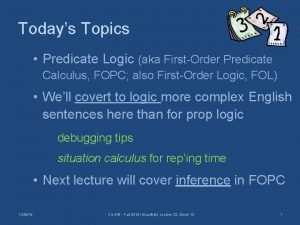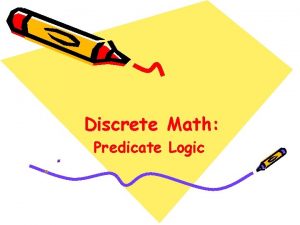Predicate Logic INT 404 K 3305 A Predicate

































- Slides: 33

Predicate Logic INT 404 (K 3305)

A Predicate Logic Example 1. Marcus was a man. 2. Marcus was a Pompeian. 3. All Pompeian were Romans. 4. Caesar was a ruler. 5. All Romans were either loyal to Caesar or hated him. 6. Everyone is loyal to someone. 7. People only try to assassinate rulers they are not loyal to. 8. Marcus tried to assassinate Caesar.

A Predicate Logic Example

An Attempt to Prove

Three Ways of Representing Class Membership

Overriding Defaults Suppose we add: Make Paulus an exception to the general rule about the Romans and their feeling towards Caesar. But now we have a problem with 5: So we need to change it to : Every exception to a general rule must be stated twice, once in a particular statement And once in exception list that forms part of general rule

Another Predicate Logic Example 1. Marcus was a man. 2. Marcus was a Pompeian. 3. Marcus was born in 40 A. D. 4. All men are mortal. 5. All Pompeians died when the volcano erupted in 79 A. D. 6. No mortal lives longer than 150 years. 7. It is now 1991. 8. Alive means not dead. 9. If someone dies, then he is dead at all later times. Is Marcus alive?

A Set of Facts about Marcus Computable predicates

One Way of Proving That Marcus Is Dead The term nil at end of each proof indicate that the list of conditions remaining is empty So the proof has succeeded.

Another Way of Proving That Marcus Is Dead • Very simple conclusion can require many steps to prove. • A variety of processes such as Matching, substitution and application of modus ponens are involved in production of proof.

Resolution • Resolution produces proof by refutation. i. e. to prove a statement, resolution attempts to show that the negation of statement produces a contradiction with known statements. • This approach contrast with technique that we have been using to generate proofs by chaining backward from theorem to be proved axioms. • It operates on statements that have been converted to a very convenient standard form. • The formula would be easier to work with if – It were flatter i. e. there was less embedding of components. – The quantifiers were separated from the rest of formula so they did not need to be consider. • Conjunctive Normal Form (CNF)has both these properties.

Algorithm : Convert to Clause Form

Examples of Conversion to Clause Form

Examples of Conversion to Clause Form Suppose we know that all Romans who know Marcus either hate Caesar or think Example : That anyone who hates anyone is crazy. 1 Eliminate 2 Reduce scope of 3 Standardize Variables.

Examples of Conversion to Clause Form 4 Move quantifiers. 5 Eliminate existential quantifiers. will be converted to while will be converted to 6 Drop the prefix. 7 Convert to a conjunction of disjuncts. Prenex normal form

Convert a matrix to conjunction of disjuncts. The Formula becomes and then becomes

The Basis of Resolution Given : Parent clauses becomes Resulting clause: resolvent 116

Herbrand’s Theorem • To show that a set of clauses S is unsatisfiable, it is necessary to consider only interpretations over a particular set, called the Herbrand universe of S. • A set of clauses S is unsatisfiable if and only if a finite subset of ground instances (in which all bound variables have had a value substituted for them) of S is unsatisfiable. 117

Algorithm : Propositional Resolution Assume that , a set of given statement F and a statement to be proved P: 1. Convert all the propositions of F to clause form. 2. Negate P and convert the result to clause form. Add it to the set of clauses obtained in step 1. 3. Repeat until either a contradiction is found or no progress can be made: (a) Select two clauses. Call these the parent clauses. (b) Resolve them together. The resulting clause, called the resolvent, will be the disjunction of all of the literals of both of the parent clauses with the following exception: If there any pairs of literals L and ¬L such that one of the parent clauses contains L and the other contains ¬L, then select one such pair and eliminate both L and ¬L from the resolvent. (c) If the resolvent is the empty clause, then a contradiction has been found. If it is not, then add it to the set of clauses available to the procedure. 118

A Few Facts in Propositional Logic We have to prove R 119

Resolution in Propositional Logic 120

Example Consider the following knowledge base: Prove by resolution theorem that the goal is derivable from the knowledge base.

Example Proof: Let us first denote the above clauses by the following symbols.

Example The CNF form of the above clauses thus become and the negated goal these 5 clauses. Set S thus includes all

Fig. 5. 3: The resolution tree to prove that it-will-rain.

Unification 121

Finding General Substitutions Given : We could produce : 122

Algorithm : Unify (L 1, L 2) 1. If L 1 or L 2 are both variables or constants, then: (a) If L 1 and L 2 are identical, then return NIL. (b) Else if L 1 is a variable, then if L 1 occurs in L 2 then return {FAIL}, else return (L 2/L 1). (c) Else if L 2 is a variable then if L 2 occurs in L 1 then return {FAIL}, else return (L 1/L 2). (d) Else return {FAIL}. 2. If the initial predicate symbols in L 1 and L 2 are not identical, then return {FAIL). 3. If LI and L 2 have a different number of arguments, then return {FAIL}. 4. Set SUBST to NIL. 5. For i ← 1 to number of arguments in L 1: (a) Call Unify with the /th argument of L 1 and the ith argument of L 2, putting result in S. (b) If S contains FAIL then return {FAIL}. (c) If S is not equal to NIL then: (i) Apply S to the remainder of both L 1 and L 2. (ii) SUBST : = APPEND(S, SUBST). 6. Return SUBST. 123

Resolution in Predicate Logic Example : Yield the substitution : Marcus/x 1 So it does not yield the resolvent : Mortal(x 1) It does yield : mortal(Marcus) 125

Algorithm : Resolution 1. Convert all the statements of F to clause form. 2. Negate P and convert the result to clause form. Add it to the set of clauses obtained in 1. 3. Repeat until either a contradiction is found, no progress can be made, or a predetermined amount of effort has been expended. (a) Select two clauses. Call these the parent clauses. (b) Resolve them together. The resolvent will be the disjunction of all the literals of both parent clauses with appropriate substitutions performed and with the following exception: If there is one pair of literals T 1 and ¬T 2 such that one of the parent clauses contains T 2 and the other contains T 1 and if T 1 and T 2 are unifiable, then neither T 1 nor T 2 should appear in the resolvent. If there is more than one pair of complimentary literals, only one pair shold be omitted from the resolvent. (c) If the resolvent is the empty clause, then a contradiction has been found. If it is not, then add it to the set of clauses available to the procedure. 126

A Resolution Proof 127

Using Resolution with Equality and Reduce 130

a h T o Y nk ! ! u!
 Sum0
Sum0 Public int divide(int a int b)
Public int divide(int a int b) Int max(int x int y)
Int max(int x int y) Interface calculator public int add(int a int b) class test
Interface calculator public int add(int a int b) class test Public void drawsquare(int x, int y, int len)
Public void drawsquare(int x, int y, int len) Int 404
Int 404 What is the alan turing test
What is the alan turing test Int 404
Int 404 Int factorial(int n)
Int factorial(int n) Int max int min c++
Int max int min c++ Interface myinterface int foo(int x)
Interface myinterface int foo(int x) Constant int arduino
Constant int arduino Char argv
Char argv Int main int argc char argv
Int main int argc char argv Int main() int num=4
Int main() int num=4 Void
Void Voidswap
Voidswap Predicate noun examples
Predicate noun examples Predicate nominative and predicate adjective
Predicate nominative and predicate adjective Predicate nominative examples
Predicate nominative examples Simple predicate and simple subject
Simple predicate and simple subject Predicate nominative and predicate adjective
Predicate nominative and predicate adjective What is predicate nominative
What is predicate nominative The gardener predicate
The gardener predicate First order logic examples in ai
First order logic examples in ai Semantics of predicate logic
Semantics of predicate logic The predicate for bob is freds father
The predicate for bob is freds father Predicate logic tutorial
Predicate logic tutorial Universal quantifier
Universal quantifier Predicate logic rules of inference
Predicate logic rules of inference Predicate logic equivalence
Predicate logic equivalence Predicate logic translation
Predicate logic translation Cryptarithmetic problem logic+logic=prolog
Cryptarithmetic problem logic+logic=prolog



